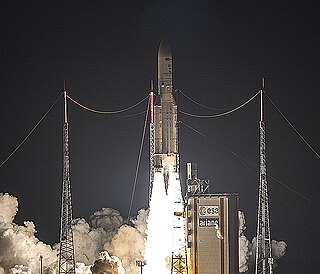AMC-3 is a commercial broadcast communications satellite owned by SES World Skies, part of SES S.A.. Launched on 4 September 1997, from Cape Canaveral, Florida, AMC-3 is a hybrid C-band / Ku-band satellite. It provides coverage to Canada, United States, Mexico, Caribbean. Located in a geostationary orbit parallel to the Yucatán Peninsula and Great Lakes, AMC-3 provides service to commercial and government customers, with programming distribution, satellite news gathering and broadcast internet capabilities.

ABS-3, formerly ABS-5, was initially named Agila 2 after the Philippine eagle, before being acquired by ABS. Launched in 1997, the satellite provided telecommunications services for Mabuhay Satellite Corporation before being sold to ABS in 2009. Built by Space Systems/Loral, the satellite provided coverage in the Asia-Pacific region. Its control station is located at the Subic Bay Freeport Zone in the Philippines. The satellite was launched by Long March 3B and positioned at 146°E longitude.
AMC-7 is a commercial broadcast communications satellite owned by SES S.A., originally from the GE Americom fleet. Launched on 14 September 2000, at 22:54:07 UTC from the Centre Spatial Guyanais in Kourou, AMC-7 provides C-band coverage to United States, Caribbean, Mexico, and is located in a geostationary orbit over the Pacific Ocean east of Hawaii. The satellite is primarily used for cable television programming distribution.

Dream Satellite TV was the first all-digital Direct-To-Home (DTH) television broadcasting service via satellite in the Philippines. Broadcasting from the Dream Broadcast Center located at the Clark Special Economic Zone in Pampanga. Content is received from program providers, compressed and broadcast via Koreasat 5 in DVB-S and NTSC color format exclusively to its subscribers using the Integrated Receiver-Decoder and the Conax/Nagravision 3 Encryption System.
EchoStar VI or EchoStar 6 is a former American communications satellite which was operated by EchoStar. In 2013, the satellite was rebranded BermudaSat 1 after the satellite was sold to a Bermudan subsidiary of SES S.A., a satellite technology company based in Luxembourg.
Intelsat 20 is a geostationary communications satellite which is operated by Intelsat. It was constructed by Space Systems/Loral, and is based on the LS-1300 satellite bus. It was launched on 2 August 2012, and replaces the Intelsat 7 and Intelsat 10 spacecraft at 68.5° East longitude. It is fully operational since September 2012.
JCSAT-110, also known as N-SAT 110, JCSAT-7, Superbird-5 and Superbird-D, is a Japanese geostationary communications satellite which was operated by JSAT Corporation and Space Communications Corporation until both companies merged into SKY Perfect JSAT Group in 2008. It is positioned in geostationary orbit at a longitude of 110° East, from where it is used to provide communications services to Japan.
Intelsat 15, also known as IS-15, is a communications satellite owned by Intelsat. Intelsat 15 was built by Orbital Sciences Corporation, on a Star-2.4. It is located at 85° E longitude on the geostationary orbit. It was launched from Baikonur Cosmodrome to a geosynchronous transfer orbit on 30 November 2009 by a Zenit-3SLB launch vehicle. It has 22 active Ku band transponders, plus eight spares. Five of those transponders are owned and operated by SKY Perfect JSAT Group under the name JCSAT-85.
AMC-15 is an American communications satellite. Owned by SES Americom, AMC-15 was designed to be placed in geostationary orbit, following launch on a Proton-M / Briz-M space vehicle.
JCSAT-3A, known as JCSAT-10 before launch, is a geostationary communications satellite operated by SKY Perfect JSAT Group (JSAT) which was designed and manufactured by Lockheed Martin on the A2100 platform.
JCSAT-2A, known as JCSAT-8 before launch, is a geostationary communications satellite operated by SKY Perfect JSAT Group (JSAT) which was designed and manufactured by Boeing Satellite Systems on the BSS-601 platform. It has Ku-band and C-band payload and was used to replace JCSAT-2 at the 154° East longitude. It covers Japan, East Asia, Australia and Hawaii.
The Geostationary Satellite for Defense and Strategic Communications is a Brazilian geostationary communication satellite that was built by Thales Alenia Space in France, it was placed in the orbital position of 75 degrees west longitude and will be operated by Telebrás. Telebrás selected Viasat as a partner to help build the associated ground system. The satellite was based on the Spacebus-4000 platform and its life expectancy will be 18 years.
Koreasat is a series of South Korean communications satellites operated by KT SAT, a subsidiary of KT Corporation.

Koreasat 7 is a South Korean communications satellite operated by KT SAT, a subsidiary of KT Corporation. Thales Alenia Space was contracted in 2014 to build both it and Koreasat 5A. Koreasat 7A was launched into geosynchronous orbit on 4 May 2017 aboard an Ariane 5 ECA launch vehicle and placed at 116 degrees east longitude to provide coverage over East Asia.
The XTAR-EUR is a communication satellite developed by Spain and the United States and in order to provide a secure channel over the Indian Ocean. It was originally operated by XTAR and Hisdesat. In year 2020 Hisdesat bought 100% stake on the satellite. Its launch short after the Spainsat is part of an effort to strengthen Spain's communication ties with allied countries around the globe, particularly in maters of national security.
AMC-12 is an American geostationary communications satellite that was launched by a Proton-M / Briz-M launch vehicle at 02:27:32 UTC on 3 February 2005. The 4,979 kg (10,977 lb) satellite to provide voice and video services to the North America and South America, Europe, and Africa through separate beams to each region, after parking over the Atlantic Ocean through its 72 C-band transponders, over 37° West longitude.
The Amazonas 5 is a Spanish commercial communications satellite developed by SSL and operated by Hispasat. Launched on September 11, 2017, it has an expected service life of 15 years. Its orbit allows it to cover all of South America, allowing for broadband and broadcast services. It replaces the Amazonas 4A and 4B satellites, the former of which experienced a performance loss and the latter which was cancelled.
Eutelsat 172B is a French communications satellite built by Airbus Defence and Space and operated by Eutelsat Communications. Launched on June 1, 2017, it has an expected service life of 15 years. Its orbit along with Eutelsat 172A allows it to cover the Asia-Pacific region, providing enhanced broadband and broadcast services.


